|
The concept of the Sephiroth and the Four Worlds is a difficult to
understand, but essential, part of Freemasonry. In his exposition upon the
degrees within Morals and Dogma[i]
Albert Pike provides exhaustive and specific discussion of both the Sephiroth
and the Four Worlds in four separate instances including “Knight of the East
and West[ii]”,
“Knight Rose Croix[iii]”, “Knight of the Brazen Serpent[iv]”,
and “Knight of the Sun or Prince Adept[v]”.
Bro. Manly P. Hall considered the concept of the Sephiroth and Four
Worlds sufficiently relevant as to publish an English translation[vi]
(the diagram was originally rendered in Latin) of Athanasius Kircher’s “Tree
of the Sephiroth” contained in Oedipus
Aegyptiacus[vii]
(1652). Hall further notes in his Secret
Teachings of All Ages[viii]
that
“the
ten globes and twenty-two channels of the Sephiroth are analogous to the
Thirty-Two Degrees of Freemasonry”.
Mackey
and Haywood note[ix]
in the Encyclopedia of Freemasonry that:
“The
Sephiroth forms the most important portion of the secret doctrine of the
Cabalists, and has been adopted and referred to in many of the high philosophic
Degrees of FreeMasonry. Some acquaintance with it therefore seems necessary to
the Freemason who desires to penetrate into the more abstruse arcana of his
order.”
The
relevance of the Sephiroth and the Four Worlds to Freemasonry is therefore
extensive, and is basic to even the Symbolic (Blue Lodge) Degrees (forming the
concept behind the Three Pillars of Masonry[x]).
This paper examines the Sephiroth
and Four Worlds by exploring a three-dimensional (3d) model proposed by Robert
Wang. Mr. Wang was a protégé of and secretary to Israel Regardie, of Hermetic
Order of the Golden Dawn fame. It’s important that I clarify at this time
that I do not ascribe to the views of the Golden Dawn, but present this model
for the sole purpose of reflecting upon an interesting concept and thereby
stimulating thought. I also would like to specify that my approach to the
Sephiroth here is consistent with the precepts of Western Herrmeticism, and not
Rabbinical tradition.
This
paper is not intended to be a discussion of basics, and in preparing it I have
made certain assumptions about the reader. It is assumed that he will know
something about the Sephiroth, including their basis and associated philosophy,
and that the reader will understand the concept of the Four Worlds which is
embodied by the Sephiroth. Readers without these prerequisites of knowledge may
find it useful to first read one of the many introductory books written about
the Sephiroth; my own recommendation to those seeking a basic grounding in the
subject is to read (and reread) the introduction provided by MacGregor Mathers
in his book The Qabalah Unveiled[xi].
I believe that for the prepared reader, this paper will be both entertaining and
thought-provoking.
The
Structure of the Sephiroth
In
order to properly address the basic concepts of this paper, an exploration of
the structure of the Sephiroth is in order. When I use the term “structure”
I am referring to the arrangement in which the individual Sephira are depicted
in a glyph intended to illustrate the concept of the Sephiroth. Since the
Sephiroth are conceptual, and not a physical reality, it is important not
to confuse the Sephirothic Glyph (Tree of Life) with anything other than a
postulated structure. Said more plainly, the Sephiroth do not exist as physical
entities. The discussion of the structure will be followed by a similar
discussion of the Four Worlds.
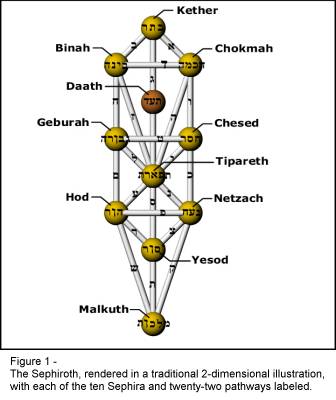 The
traditional method for illustrating the Sephiroth (Figure 1) is by a
2-dimensional glyph or diagram. In
those instances in which the glyph has been modified by shading in an attempt to
add depth (i.e. to illustrate the spheres) the result is a figure which remains
essentially planar or two-dimensional. The problem of illustrating the four
worlds of the Sephiroth using such a planar model is usually resolved by drawing
four separate Sephiroth one beneath the next, often creating a confusing
representation of that which it is intended to illustrate.
The
traditional method for illustrating the Sephiroth (Figure 1) is by a
2-dimensional glyph or diagram. In
those instances in which the glyph has been modified by shading in an attempt to
add depth (i.e. to illustrate the spheres) the result is a figure which remains
essentially planar or two-dimensional. The problem of illustrating the four
worlds of the Sephiroth using such a planar model is usually resolved by drawing
four separate Sephiroth one beneath the next, often creating a confusing
representation of that which it is intended to illustrate.
One
method of illustrating the four worlds was used by Robert Wang as a rear dust
cover photo in the hardback version of his book Qabalistic Tarot[xii].
This method involves placing the Sephiroth of each world in true 3-dimensional
perspective, with twelve Sephiroth forming a double cube and with a single
column of Sephiroth vertically positioned in the center of the double cube. I
have reproduced this arrangement in Figure 2 using a computerized drawing
system. Please note that in Wang’s model, which appears to have been made of
wood, each Sephira and each Pathway is colored to coincide with the beliefs of
the Golden Dawn concerning colors and energies. In my reproduction I have not
colored, nor have I labeled the Sephiroth or the Pathways. I believe my result
to be otherwise true to the Wang model, and have spent considerable time
rotating and manipulating the 3d image so that I could examine it just as Wang
no doubt examined his wooden model. Note that in Figure 2 I have presented two
views of the 3-Dimensional Sephiroth, each rotated to a slightly different
orientation to better illustrate the structure as a whole. In Figure 3, I have
rotated the model to present a view looking down into the Sephiroth from the
very top. My reason for providing this particular view will soon be made
apparent.
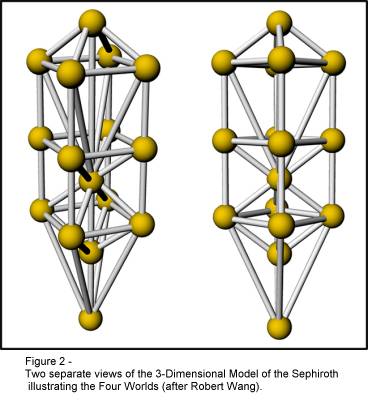 The
pathways in both views are represented as tubular connectors, which again is
true to both Wang’s model and the traditional representation of the Sephiroth.
One of the interesting features of the Sephiroth, when drawn in 2-dimensions is
that the individual Sephira are laid out in a circular pattern[xiii].
When considering the 3-dimensional model, the layout of the Sephira is
spherical. The top view in which the center column, or column of Beauty,
is shown fits into this same spherical layout.
The
pathways in both views are represented as tubular connectors, which again is
true to both Wang’s model and the traditional representation of the Sephiroth.
One of the interesting features of the Sephiroth, when drawn in 2-dimensions is
that the individual Sephira are laid out in a circular pattern[xiii].
When considering the 3-dimensional model, the layout of the Sephira is
spherical. The top view in which the center column, or column of Beauty,
is shown fits into this same spherical layout.
Recently,
during a spirited Philalethes Society discussion list conversation concerning
the phrase “4th part of a circle”, one of the participants offered the
following quotation from The Way of The
Craftsman[xiv], by W. Kirk MacNulty:
“…
Now the circle is an almost universal symbol for the whole of existence, the
relative universe which contains the four worlds according to our cosmology. The
“fourth part of a circle” makes reference to one of the four worlds”
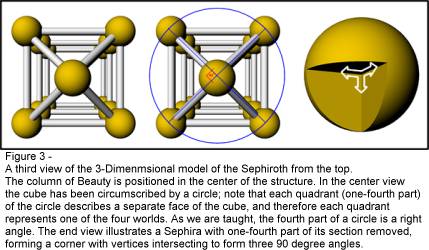 If
one is to examine the top view of the 3-dimensional model in Figure 3, it
becomes apparent that if the top cube of the Sephiroth is circumscribed by a
circle, that circle would be divided into four equal segments (by the X-shaped
connecting pathways), with each quadrant forming a ninety-degree angle. Each
quarter circle then would indeed describe one of the four worlds in our
3-dimensional model.
If
one is to examine the top view of the 3-dimensional model in Figure 3, it
becomes apparent that if the top cube of the Sephiroth is circumscribed by a
circle, that circle would be divided into four equal segments (by the X-shaped
connecting pathways), with each quadrant forming a ninety-degree angle. Each
quarter circle then would indeed describe one of the four worlds in our
3-dimensional model.
While I’m on the
subject of 3-dimensional views of the Sephiroth, I would like to offer that
there is a strong correlation between the traditional 2-dimensional view of the
Sephiroth and the double-cube used by Wang in his 3-d model. In Figure 4 I have
provided two views of the double cube used to represent the four worlds (less
the inner column) along with a 2-d view of the Sephiroth as it is traditionally
rendered.
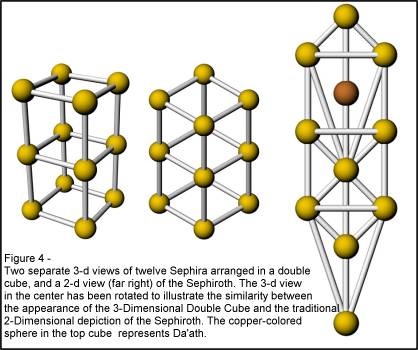 The reader will notice the unusual similarity between the center view of
the double cube in Figure 4, and the traditional 2-d representation of the
Sephiroth at the far right. This similarity may actually be at the root of the
evolution of the diagram of the Sephiroth[xv]
since its pattern or form is not specifically established in the Sefer
Yetzirah[xvi].
The reader will notice the unusual similarity between the center view of
the double cube in Figure 4, and the traditional 2-d representation of the
Sephiroth at the far right. This similarity may actually be at the root of the
evolution of the diagram of the Sephiroth[xv]
since its pattern or form is not specifically established in the Sefer
Yetzirah[xvi].
The
Four Worlds
The Four Worlds
are comprised of: Atziluth the world of Emanation and Deity, which is sometimes
considered related to the Christian concept of the Holy Spirit; Briah, the world
of creation (or the Archangelic realm) in which the mind is first given
expression; Yetzirah, the world of formation (Angelic realm) - equivalent to the
Christian concept of Purgatory[xvii];
and Assiah, the material world (the world of action, or movement). Of all of the
various beliefs expressed in Kabalistic literature, it is the concept of the
Four Worlds which tends to be the most difficult to comprehend
Even the most basic description of the Four Worlds here would be
impractical given limitations of the scope and length of this paper; suffice it
to say that this is an extremely abstract concept, and that the subject requires
a well grounded understanding of the Sephiroth as a whole. I intend in this
discussion to stay focused upon a few specific aspects of the four worlds as
they relate to the 3-d model proposed by Wang and as illustrated herein.
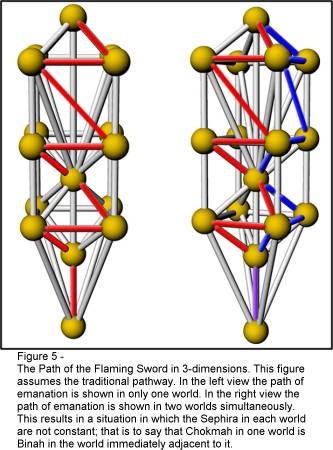 When
evaluating the four worlds in a 3-d perspective, consideration was given to the
manner in which the emanations are propagated from Kether to Malkuth in each of
the Four Worlds. Golden Dawn Tradition holds that the pathway for the emanations
is a sort of zig-zag pattern (beautifully illustrated in a Plate preceding the
Fifth Knowledge Lecture in Isreal Regardie’s The
Golden Dawn[xviii]) often called the Path of the Flaming Sword[xix].
Figure 5 illustrates this path two ways; first with the path viewed as it
propagates in only one world, and then with the path viewed as it progresses in
two worlds simultaneously. The
reader will no doubt recognize that in practice the emanation will progress
identically and simultaneously in all four worlds. Note also that as the
emanation proceeds from Binah to Chesed, it does not follow an established
pathway. The “gap” through which the emanation passes is often considered to
represent the Abyss, which is the separation between the three supernal
Sephiroth and the seven lower Sephiroth. The concept of The Abyss is often
identified with Tohu Bohu (Chaos and Emptiness) in Genesis 1:2 [xx].
Some Cabalists also associate the Abyss with “Qlippoth”, which are scattered
shells of Sephiroth which shattered during initial failed attempts at creation
as the result of imbalance in the Tree of Life. There are many more explanations
for The Abyss, however that which I find particularly compelling is that
espoused by Isaac Luria[xxi]
(1534 -1572) which came to be known as “tzimtzum” or expansion and
contraction.
When
evaluating the four worlds in a 3-d perspective, consideration was given to the
manner in which the emanations are propagated from Kether to Malkuth in each of
the Four Worlds. Golden Dawn Tradition holds that the pathway for the emanations
is a sort of zig-zag pattern (beautifully illustrated in a Plate preceding the
Fifth Knowledge Lecture in Isreal Regardie’s The
Golden Dawn[xviii]) often called the Path of the Flaming Sword[xix].
Figure 5 illustrates this path two ways; first with the path viewed as it
propagates in only one world, and then with the path viewed as it progresses in
two worlds simultaneously. The
reader will no doubt recognize that in practice the emanation will progress
identically and simultaneously in all four worlds. Note also that as the
emanation proceeds from Binah to Chesed, it does not follow an established
pathway. The “gap” through which the emanation passes is often considered to
represent the Abyss, which is the separation between the three supernal
Sephiroth and the seven lower Sephiroth. The concept of The Abyss is often
identified with Tohu Bohu (Chaos and Emptiness) in Genesis 1:2 [xx].
Some Cabalists also associate the Abyss with “Qlippoth”, which are scattered
shells of Sephiroth which shattered during initial failed attempts at creation
as the result of imbalance in the Tree of Life. There are many more explanations
for The Abyss, however that which I find particularly compelling is that
espoused by Isaac Luria[xxi]
(1534 -1572) which came to be known as “tzimtzum” or expansion and
contraction.
The reader will
recall that the Sephiroth in the pillar of Wisdom are considered Feminine and
those in the pillar of Justice are considered Masculine, with the center pillar
of Beauty considered neutral (i.e. androgynous). This concept is alluded to in
the Christian Bible[xxii]
(Proverbs 8:1) when Solomon declares:
"Does
not wisdom call out? Does not understanding raise her voice” (emphasis
is the author’s)
An
even more specific reference to the feminine nature of Wisdom[xxiii]
is found in Proverbs 3:13:
"Happy
is the man that findeth
wisdom, and the
man that
getteth understanding....She is a tree of life to them
that lay hold upon her:
and happy is every one that
retaineth her”.
The
import of this is that each Sephira at any given moment of emanation is either
male or female depending upon which of the outermost pillars it occupies, but
combines to beconme androgynous when it occupies the center pillar. This
androgynous character appears to separate and recombine several times as the
emanations progress throughout the Sephiroth. Some would argue that the
androgynous aspect, after passing through Tipareth, is subsequently separated,
but that at the point at which the
pathways converge in Yesod the male and female aspects are again recombined and
are passed to Malkuth without further separation.
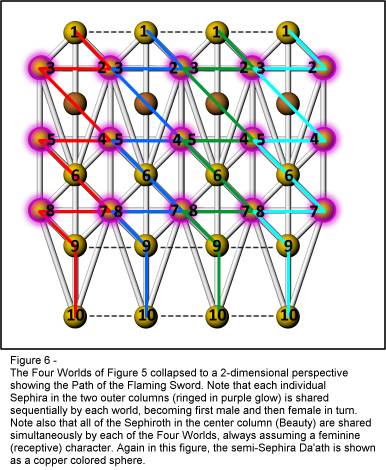 Tradition,
on the other hand holds that the Male and Female aspects are separately passed
to Malkuth, and that through the holy institution of Marriage the two are
brought back together again. This concept is of course related to the
prohibition of divorce in some religious traditions and denominations.
Tradition,
on the other hand holds that the Male and Female aspects are separately passed
to Malkuth, and that through the holy institution of Marriage the two are
brought back together again. This concept is of course related to the
prohibition of divorce in some religious traditions and denominations.
Given
the construction of the 3-d Sephiroth, the Sephira designated “Chokmah” in
one world would be regarded as “Binah” in that world to which it is
adjacent. This interesting characteristic seems to coincide with a passage from The
Zohar which (in speaking of the emanation of light) translates as “the Left was included in the Right and the Right in the Left."[xxiv]
Careful
evaluation of Figure 5 (Wang’s model) will lead the reader to recognize that
at no point is any single Sephira involved in, nor interacts with, more than one
world at a given time. I would make the analogy
that the Sephiroth is like an automobile engine. In an engine, each cylinder
receives a spark in a progressive sequence (as opposed to all cylinders being
fired simultaneously). In some cabalistic literature the Path of the Flaming
Sword is also referred to as a lightning flash; this would seem to be an
especially apt description if the 3-d representation in Figure 5 is indeed
correct. I interpret here that a “flash” is a rapid, but discontinuous
event, and that the flash is analogous to the sparking of an engine cylinder.
It
is apparent from Figure 5 and from Figure 6 (if folded in such a manner as to
recreate its 3-dimensional perspective), that each individual World has one
Parallel World in which the emanations are in phase, and two Adjacent Worlds
which are Perpendicular and ninety degrees out of phase. This is, to say the
least, a very complex structure. I leave the reader to ponder the significance
of the terms “parallel” and “perpendicular” in this context (hint: what
are signs ?).
Conclusion
In closing, I would restate the fact that The Sephiroth and their related
philosophy are indeed an important element in the more philosophic aspects of
what is often called Esoteric Freemasonry.
Given the importance then of The Sephiroth, an exploration of the more
difficult, but related concept of the Four Worlds would seem reasonable. I have
chosen just one of the many possible forms of the Sephiroth for discussion here;
I hope that the reader will agree that this exploration has been worthwhile, and
that with further exploration of other possible structural forms, greater
understanding of the Sephiroth will perhaps evolve. I would also like to mention
to my Orthodox friends that I understand that much of my speculation could be
considered disrespectful of established tradition and deeply held beliefs. I
would sincerely hope that they will accept that no offense or disrespect is
intended.
The author is grateful to Bro. Ben Williams, Telluride Lodge No.
56 (Grand Lodge of Colorado) who kindly reviewed and edited this paper greatly
improving it in uncountable ways. Remaining errors, omissions, and poor grammar
in this paper remain the fault of the author, so don’t blame poor Ben
<Grin>.
[i]
Pike, Albert. (1871). Morals
and Dogma of the Ancient and Accepted Scottish Rite of Freemasonry.
Supreme Council for the Thirty-Third Degree of the Southern Jurisdiction of
the United States. Charleston.
[vi]
Tyson, Donald. Athanasius
Kirchner’s Tree of the Sephiroth. Retrieved March 2, 2009 from http://www.donaldtyson.com/kircher.html.
[vii]
Kirchner, Athanasius . (1652). Oedipus
Aegyptiacus. Accessed March 9, 2009 and Available for Download from
http://www.billheidrick.com/Orpd/AKir/AKOeAeII.htm.
[viii]
Hall, Manly P. (1928). The Tree of the Sephiroth. The Secret Teachings of All Ages: An Encyclopedic Outline of Masonic,
Hermetic, Qabbalistic & Rosicrucian Symbolical Philosophy.
Philosophical Research Society; Revised edition (June 1978). . pp 329.
ISBN-10: 089314830X; ISBN-13: 978-0893148300.
[ix]
Mackey, Albert Gallatin and
Haywood, H.L. (1909). An Encyclopedia of Freemasonry Volume 2. pp 924.
Retrieved FebruRY 28, 2009 from http://www.phoenixmasonry.org/mackeys_encyclopedia/s.htm.
[x]
Burkle, William S.
(2008). . The Broken Pillar and It’s Deeper
Meaning. 2008. Pietre-Stones
Review of Freemasonry. http://www.freemasons-freemasonry.com/broken-column.html.
[xi]
Mathers, S.L. MacGregor.
(1887). Qabalah Unveiled. Reprinted (2006) as The Kabbalah: Essential
Texts From The Zohar. Watkins. London. pp. 10. ISBN-10: 1-84293-128-9;
ISBN-13: 9-781842-931288.
[xii]
Wang, Robert. (1983). The Qabalist
Tarot. Samuel Weiser. New York. ISBN: 0-87728-520-9.
[xiii]
Burkle,
William S. (2009). . Two Esoteric Masonic
Concepts Which Are Linked by the Tetragrammaton. Pietre-Stones
Review of Freemasonry. http://www.freemasons-freemasonry.com/esoteric-masonry-tetragrammaton.html.
[xiv]
MacNulty, W. Kirk. (2002). The
Way of the Craftsman. Central
Regalia Ltd. ISBN-10: 0954251601; ISBN-13: 978-0954251604.
[xv]
Tree of Life or
Sephiroth. Aiwaz.net
Encyclopedia. (2008). Retrieved
March 2, 2009 from http://www.aiwaz.net/encyclopedia/tree-of-life-or-sephiroth/e78.
[xvi]
Kohler, Kaufmann &
Ginzberg Louis. Yezirah Sefer.
Jewish Encyclopedia. Retrieved February 28, 2009 from http://www.jewishencyclopedia.com/view.jsp?artid=40&letter=Y.
[xvii]
Bain, Alan. (1992). The Keys to Kabballah. Retrieved March 13, 2009
From http://m_euser.tripod.com/articles/keys_to_kabbalah.htm.
[xviii]
Regardie, Israel. (1937). The Golden Dawn. Aires Press. Chicago. pp. 152.
[xix]
Flaming Sword. Qabalistic
Dictionary.
Esoteric
Order of the Golden Dawn.
Retrieved
March 6, 2009 from http://www.esotericgoldendawn.com/mysteries_qbldictionary.htm.
[xx]
Tohu Bohu. Babylon
Dictionary. Retrieved March 13, 2009 from http://dictionary.babylon.com/Tohu_Bohu.
[xxi]
Schultz, Joseph P. (1981). Judaiism
and the Gentile Faiths. Fairleigh
Dickinson University Press. pp.
89. ISBN:
0838617077, 9780838617076.
[xxii]
Warren, Lee. (1999). Male and Female Androgyny. Plim Report, Vol. 8 #3. Retrieved March 12, 2009 from http://www.plim.org/Male%20and%20Female%20Androgyny.htm.
[xxiii]
Low, Colin (1992). Notes on Kabbalah. Retrieved March 8, 2009 from http://www.digital-brilliance.com/kab/nok/q9.txt.
[xxiv]
The Zohar. (c 1280 A.D.). H. Sperling and M. Simon, trans.
(1931-34). pp. 70, cit. Armstrong, Hamilton Reed. Fundamentals of Symbolism
Part II: From the Renaissance to Modern Times. Retrieved March 12, 2009
from http://www.agdei.com/Universal%20Symbols2.html.
|
![]() News Feed |
News Feed |  Subscribe News by Email
Subscribe News by Email